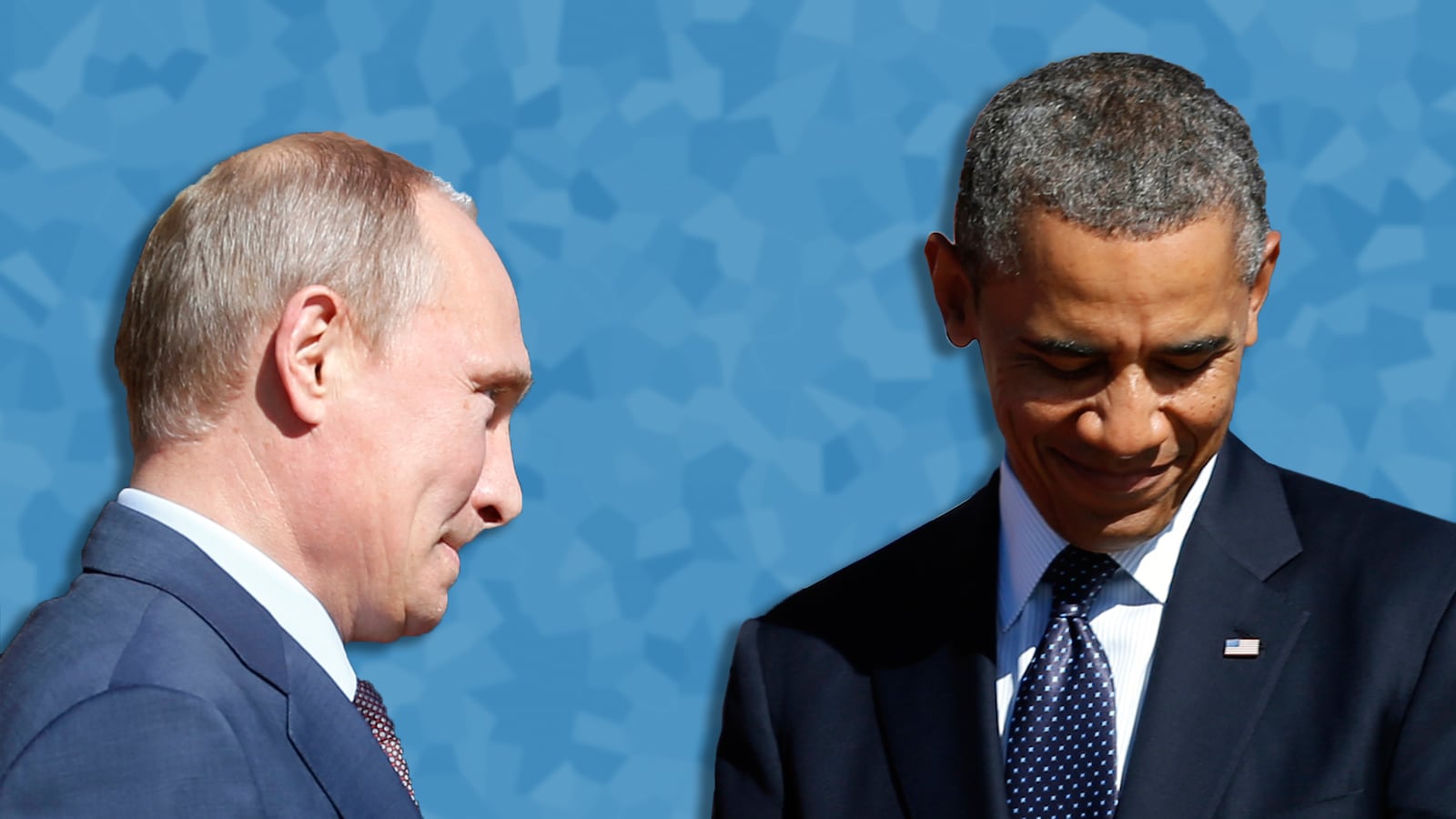Every time a U.S. military commander calls Russia the biggest threat to the United States, the White House fumes.
In recent weeks, there’s been a dramatic, if little noticed, shift in how the Pentagon talks about the world. Russia—once dismissed as a military has-been—is now being regarded as an enemy with the potential to do “existential” damage to America. Everyone from the incoming chairman of the Joint Chiefs of Staff on down is raising the alarm about a Russia that is revamping its nuclear arsenal, launching ultra-sophisticated cyberattacks, and, of course, stirring up trouble in Eastern Europe. And that talk is not sitting well with the staff at 1600 Pennsylvania Avenue.
Russia is just one of myriad threats, White House officials say—calling it a top threat is a step down a slippery slope toward the risk of conflict. And the talk from the Pentagon about arming the Ukrainians, so they can resist Putin? The White House is having none of it. Putting more weapons in the hands of Russia’s enemies would only create an excuse for more Russian violence, the White House worries, just as they are trying to secure a sustainable cease-fire.
The Ukrainians and America’s NATO allies in the Baltics “need to see us take action right away,” a senior defense official said. But the administration’s approach is to avoid “getting involved in any kind of conflict…They’re being a little too timid.”
Of course, nobody wants a wider war with the Russians; that’s a recipe for courting Armageddon. “But is giving lethal defensive weapons to the Ukrainians really going to do that?” the senior defense official asked. “Remember, the Russians don’t want to go to war with us, either.”
The questioning of the Russia threat has exposed an administration—and at times a Pentagon—divided about how to respond to threats to the United States. While the White House is seemingly focused on the nuclear deal with Iran—a deal forged with Moscow’s cooperation—the commanders are increasingly worried about the return of the Russian bear.
Top defense leaders believe that calling Russia a top threat paves the way to arm Ukrainians confronting Russian forces. Politically, they want the administration to recognize Russia as a top threat so they can devote the proper budget, sourcing, and troop resources to it. So far: no dice.
“The administration thinks the ranking of threats is not the most productive way to devise a strategy. But we are saying, ‘How else do we allocate increasingly limited resources?’” a second defense official explained.
“We have a nation that has used force to change internationally recognized boundaries,” General Philip Breedlove, commander of U.S. and NATO troops in Europe, told PBS NewsHour last week, the latest example of a commander talking about the Russia threat. “Russia continues to occupy Crimea. Russian forces now are in the Donbass in eastern Ukraine. So this nation has used force to change international boundaries. And this is a nation that possesses a pretty vast nuclear inventory and talks about the use of that inventory very openly in the past.”
The military’s pleas are a public manifestation of a 16-month assessment that has been making its way around the world to top U.S. generals. The warnings grew more dire with each Russian provocation, bellicose statement, and violation of hard-fought cease-fire negotiations in the war with Ukraine.
“Most assumed that the means of Russian pressure on Ukraine would be economic and perhaps an energy cutoff,” not military action, Steven Pifer, a former U.S. ambassador to Ukraine and a senior fellow at the Brookings Institution, told The Daily Beast.
That’s not what happened. Russia seized the Crimea region of Ukraine and then backed Russian-speaking rebels in eastern Ukraine with weapons, training, and elite Russian troops.
“They are seeking a Cold War sphere of influence,” explained a third defense official, referring to Russia.
Russia’s ascent, among top U.S. military generals, as the top threat to the U.S. began with a widely circulated classified briefing born out of Russia’s 2014 annexation of Crimea, the defense official told The Daily Beast. It was February 2014, and Russian forces had entered Crimea and installed a pro-Russian government. A month later, the Black Sea peninsula had seceded, and Russia successfully redrew the region’s map, all while dismissing international norms.
Like their counterparts in the Middle East caught off guard by ISIS’s capture of the Iraqi city of Mosul, U.S. commanders for Europe hastily began preparing a brief about the Russian threat. Soon, the intelligence community, the Pentagon, and the State Department added their input. And one four-star after another got the brief that Russia was a growing threat.
With each Russian move—its incursion into eastern Ukraine, its president’s bellicose rhetoric, its violations of cease-fire negotiations—the military updated its brief, each time raising its assessment of the Russian threat.
In February 2014, the U.S. Air Force deployed 12 A-10 Thunderbolt II aircraft and approximately 300 airmen to train alongside their NATO counterparts. That spring, the Army deployed a company of troops to each of the Baltic states and Poland. Military equipment followed.
But it was the publication of Russia’s revised military doctrine at the end of 2014 that raised the threat from a regional matter to a global one. Not only did the document list NATO as the top threat to Russia, it also claimed for Moscow “the right to use nuclear weapons…in a case of an aggression against her with conventional weapons that would put in danger the very existence of the state.” In other words: a nuclear first strike.
The publicly pro-nuclear position—combined with Russia’s new investment in strategic weapons and advanced satellites, Moscow’s new willingness to deploy its nuclear-capable bombers, and the Kremlin leaders’ loose talk about using that nuclear arsenal—began to worry the Pentagon brass deeply.
“At DOD, we deal in worst-case scenarios,” the senior defense official said, using an acronym for the Department of Defense. “And now we’ve got this guy [Putin] deciding whether to launch? It’s a little bit scary.”
Compounding the concerns was a growing belief that Russia was the United States’ most sophisticated adversary online—even more so than China’s hackers, who recently made off with the personal information of tens of millions of government employees and their families. “I worry, frankly, more about the Russians, who are a lot more subtle and a lot more sophisticated about purloining our information,” Director of National Intelligence James Clapper told Congress.
Russia’s sophistication in the war of ideas—with a global machine in the RT network and a small army of Twitter trolls—only added to the sense of a worldwide face-off.
At the same time, the Pentagon underwent an unusually high turnover period, replacing nearly every top general. Each one appeared before Capitol Hill to answer the same question: What is the biggest threat to the United States?
General Joseph Dunford, slated to be the next chairman of the Joint Chiefs of Staff, his soon to be vice chairman, General Paul Selva, and the Army’s next top general, Mark Milley, agreed with a longtime assessment by General Breedlove that it was Russia. It is the only country in the world that could destroy the United States, given its vast nuclear weapons program and its president’s aim to break up the NATO alliance, they concluded.
“Russia presents the greatest threat to our national security,” Dunford asserted during his congressional confirmation hearing last month.
Dunford received a quick rebuke from the White House immediately afterward.
“These kind of assessments are dynamic,” White House press secretary Josh Earnest said after Dunford’s statement. The general “has his own view, but I think he would be the first to admit that that’s—reflects his own view, and not—and doesn’t necessarily reflect the view of—or the consensus analysis of the president’s national security team,” Earnest said.
Regardless, the Pentagon already has begun making modest military adjustments. The U.S. military has moved 150 troops into the Baltic region and Central Europe, pre-positioned heavy equipment, conducted more exercises with its allies, and allotted nearly $1 billion to address the rising military threat.
The Pentagon’s 2015 budget allotted nearly $1 billion to “provide near-term flexibility and responsiveness to the evolving concerns of our allies and partners in Europe, especially Central and East Europe.” But the White House has said no to any efforts to provide lethal aid to Ukraine.
In his February confirmation hearing, Secretary of Defense Ash Carter all but endorsed giving the Ukrainians weapons. The White House quickly shot the idea down, much to the consternation of the Pentagon.
But while the military has been ringing the alarm bells, not everyone has been listening. Even some of the Pentagon’s top leaders aren’t convinced.
And it should be noted that each of the generals who spoke about a Russia threat came up through the ranks of a military that prepared for a war with the Soviet Union. It is a construct they have known—and been getting ready for—for decades. To resurrect that threat, some argue, is to bring back a comfortable, conventional foe in the face of a rising asymmetric one like ISIS.
An April CNN poll among Americans asked what is the biggest threat to the country. Russia came in behind ISIS, Iran, and North Korea.
Michael McFaul, professor of political science at Stanford University and former U.S. ambassador to Russia, said ranking the Russia threat was ancillary. The military’s responsibility is to make the public aware of future threats, he said.
The U.S. military leadership “is trying to bring attention to this new threat. They will be the ones that will go before the president and say, ‘This is the contingency plan,’” McFaul said. “We are going to be dealing with the Russian challenge for a long time. Preventative action could help you avoid military action later.”







